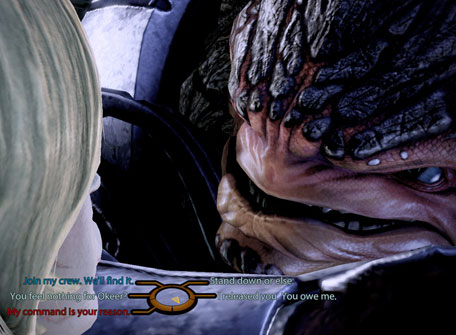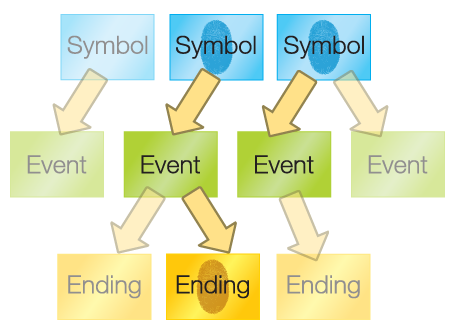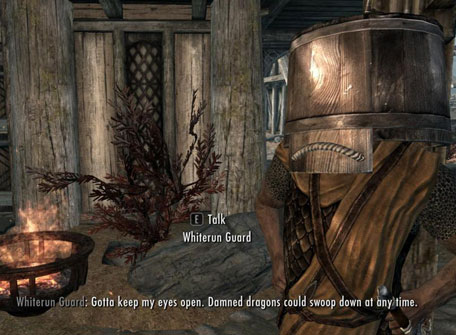This is the first of a four-part series (here’s part two, part three, and part four) getting into some of the meaty details of Ice-Bound. If you want to read a more detailed, techy explanation, check out our paper for FDG 2014: Ice-Bound: Combining Richly-Realized Story with Expressive Gameplay.
First up is combinatorial narrative, as we think this is the heart of what sets Ice-Bound apart from other story-games. It’s fairly complex, but we’re going to try and distill it down into something easily digestible. If you’re interested and still have questions after reading, just leave a comment! Trust me, we’ll talk your ear off about it.
Ok so…combinatorial narrative?

Combinatorial narrative is where several sections of text can be combined in different ways to yield significantly different stories. This differs from branching narrative, which is the go-to for most works that want players to have a hand in how the story unfolds.
Games like Bioware’s Mass Effect series or TellTale titles (The Walking Dead, The Wolf Among Us) focus on making stories reactive by offering a couple discrete choices (usually between two or three options) and making that choice pay out in a big way (or making it appear to do so). But there’s a devilish double-bind designers run into with this approach:
- If you want the choice to matter, you need to write a really good story to reflect that, but
- if you want to write a really good story, it’s probably going to be by hand, which means
- you’re going to be spending time producing stuff that many people won’t see.
A lot of games try to compromise for this by reducing the impact of choices to simply adding flavor. Meaning, there’s no way to not crash-land your spaceship into the asteroid and steer it away from Earth, only ways to change how that plays out. You don’t change the story per se, but more change the flavor of the context for those narrative events. This makes for a great initial game experience that seems really responsive, but on a second playthrough usually yields complaints from players once they realize they aren’t changing the meat of the experience, only the wrapper.
Yet trying to change the events themselves is insanely labor-intensive. I wrote a hyperfiction piece called Forest that took the form of offering readers a choice between two things ten times. Not so bad, right? I ended up writing a novel’s-worth of text for a piece as long as a short story. It was an interesting exercise to make a point, but not one I’m in a hurry to make again.
Combinatorial narrative, however, can get more of your writing in front of the reader, and the possibility space gets big really quick. But if you’re writing a combinatorial narrative, you can’t really just combine anything together willy-nilly, because you want to approach the kind of coherency that hand-authored narrative gives you. You need some kind of structure so that the different parts fit together more seamlessly.
So what’s the structure?

Ice-Bound has three types of texts: symbols, events, and endings. Symbols are the scene setters, the smoking guns, the MacGuffins. It might mean a character is paranoid, or had a troubled childhood, or is pining for a lost loved one.
Events are texts revolving around the main action of the story. They have “pre-conditions”, which means they only activate under certain circumstances. For example, there may be an event revolving around a violent confrontation if a character is paranoid. But if the player deactivates that symbol and switches it to “pacifist”, it in turn deactivates the violent confrontation event, and activates a different event where the two characters have a reasonable discussion.
Endings work in the exact same way, except keyed off of events (usually). So by simply deciding which symbols are active, readers control the flow and outcome of each story. For us, it means we can build way more possible stories, that are far more tailored, but still write a relatively small amount of text. It also means a lot more of what we write gets seen, which translates into being more effective authors.
Soft-edged Puzzle Pieces
You can’t just combine text though. Well, you can but unless you’re making some kind of post-structuralist, collage narrative, you have to be sure there’s a through-line, a thread of context readers can follow. A light they can follow through the desert.

Defining that thread, that light, is tricky business. Fall into the trap of simulation, and you’ll want to make a model of everything that’s happening in the story. What if the object the main character picks up is the thing they set down on a table in the second event? What if the system knows things go on tables? Wait what is a table? Never mind…what if the system knows when two characters are in a room together, setting things on tables?
You can go down this rabbit hole, and many systems have tackled the problem, with varying levels of success. For us, we knew we wanted to keep the focus on interesting stories, without getting bogged down with simulating the space of the story. So wherever possible, we want to leave it to the reader to draw the line between the dots. It feels like cheating, but we’re not hand-waving the problem. We do want to make sure there is some baseline consistency.
A lot of that boils down to characters, and how they’re tagged by the system. We use grammars like _characterWithTrait/feisty/ to make sure the right characters end up in the right scenes. And if we do some simple thinking like “hey, this event requires a feisty symbol, so I know there’s a feisty character in here somewhere…” or “I know the character has had some sort of confrontation with their teammate because this ending requires that kind of event, so maybe it can reference that like this…”
Also, honestly, we go with our instincts. And then we use fancy tools sometimes to double-check our assumptions. But that’s a topic for a different post.
So we author these chunks of story, these puzzle pieces, and soften their edges with grammars so that they’re relatively adaptable. It’s a delicate dance, writing something between text that can be used always, or only used once. We shoot to write text that can show up several times, with clever ways to make it adapt to each context so it feels more like it was written just for that context. And we make sure the conditions for each one, the bindings between symbol, event, and ending, are robust as well.
All those things working together is Ice-Bound‘s unique take on combinatorial narrative. We’ll be posting more about other aspects in the next entry, but if you have any questions now, fire away! If you want a heads up when we pull back the curtain some more, feel free to follow us on Twitter or Facebook, or if you just want to know when Ice-Bound is out, you can go to ice-bound.com and sign up there. Thanks!
Great read. This is a very interesting dialog to me, as I spent two years building a game engine for a CYOA horror story, but one where the players could read existing stories, or build their own node based adventures to share. We had 24 beginning stories, and my partner authored those. (I did a few when I wasn’t programming/doing art). We found that the process became easier, but that the traps you list above: making choices matter! without creating a ton of content nobody saw were all too easy to fall into. In the end, we chose key choices for great storytelling, but it was indeed exhausting work and we knew that our audience creators would likely struggle with this too much.
I’m excited you’ll be at IndieCade – look forward to chatting with you more about the solutions you’ve used and seeing Ice-Bound!